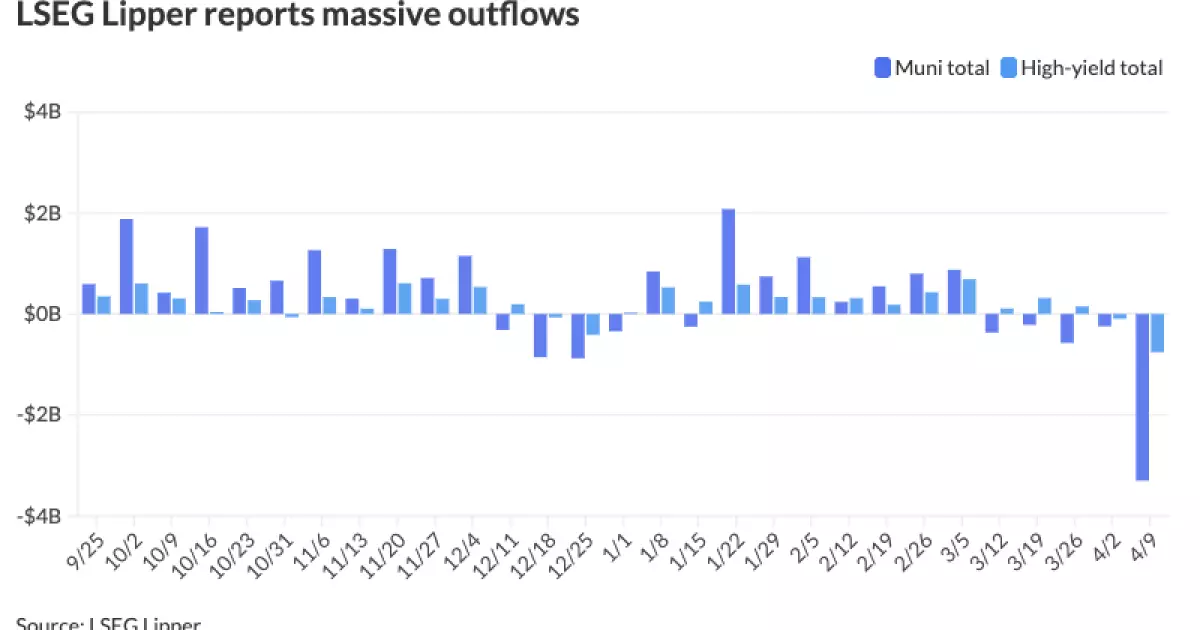Municipal bonds are not for the faint of heart. Just when investors begin to feel secure about their holdings, events unfold that signal instability once again. Recently, the municipal bond market experienced an unexpected rally, reversing losses that had accumulated just a day prior. While some see this as a sign of resilience, others might argue that it’s merely a mirage—a brief respite in a landscape fraught with economic uncertainty. The 90-day tariff extension and a lower-than-expected consumer price index (CPI) certainly injected a dose of optimism. Still, the volatility that characterized the previous week was a stark reminder of the complex forces at play in financial markets.
Observers noted that municipal bond mutual funds suffered outflows totaling a staggering $3.3 billion—the highest amount seen since June 2022. This trend reflects a deeper malaise, indicating that many investors may be recalibrating their strategies, seeking refuge in more stable assets. Meanwhile, exchange-traded funds (ETFs) holding municipal bonds witnessed their own record outflows, a troubling sign that market participants are increasingly jittery about the ever-changing economic landscape.
The Inflation Dilemma: Perception vs. Reality
The recent consumer price index report indicating a year-over-year rise of just 2.4%—lower than the anticipated 2.6%—was initially seen as a silver lining. Yet, one can’t help but wonder whether this easing of inflationary pressure is temporary. Mark Paris, chief investment officer at Invesco, highlights a critical point: the expectation of stability fueled the market’s brief rally. However, it begs the question—are we simply ignoring the looming specter of inflation that could re-emerge after mere weeks of reprieve? The excitement felt on Thursday might be replaced by trepidation as we scrutinize upcoming economic data releases.
What’s troubling is the murky waters surrounding the U.S. Treasury market. As Treasury yields have begun to rise again, there is a palpable sense of anxiety amongst investors. Market participants are speculating about potential scenarios unfolding over the weekend, indicating that the fear of the unknown remains a dominant force. Investors appear caught in a balancing act, unsure whether to double down on their investments or retreat to safer pastures. It’s an emotionally charged environment, filled with uncertainty about what lies ahead.
Tariffs and Tensions: The Unseen Hand of Policy
One of the most significant factors influencing market volatility is the ongoing tariff debate. Despite recent pauses implemented by the Trump administration, the uncertainty surrounding trade policy continues to cast a long shadow over bond markets. As Michael Pietronico, CEO of Miller Tabak Asset Management, points out, the ramifications of these policies are likely to ripple through municipal finances for months to come. Investors need to be acutely aware of potential policy announcements that could shift the market’s landscape dramatically.
While some may offer platitudes about stability, the reality is that bond valuations remain vulnerable to the whims of policymakers. Investors have witnessed a blend of political posturing and economic turbulence, ramping up the stakes for both municipal and corporate bond markets. A “yield shock” in the coming days could swiftly alter the dynamics, sending the markets spiraling downward once more.
Muni Market: Under Pressure from Supply and Demand
Even in a more stable economic environment, municipal bonds face unique challenges. The increasing supply coupled with uncertainty regarding tax policy in Washington, D.C., generates headwinds that cannot be ignored. Tom Murphy, a senior analyst at Morningstar, rightly notes that inflows into municipal bonds saw a promising uptick earlier this year but then began to dwindle as demand cooled. This decline in inflows indicates a growing reluctance among investors to engage with the municipal bond market, which is precisely where many were expected to channel their resources.
Outflows from municipal mutual funds have now reached five consecutive weeks, a trend only amplified by the recent $3.3 billion pullback. Investors are clearly losing confidence in a market once regarded as a stable haven. Even high-yield funds, which typically attract those seeking greater returns, are not exempt from this distress, indicating widespread wariness that permeates all levels of the market.
Looking ahead, investors must brace themselves for an unpredictable landscape. The recent rally might provide temporary solace, but the underlying factors suggest a more volatile future. The interplay of economic data, policy decisions, and investor sentiment could shape the trajectory of municipal bonds. Ultimately, while some may claim that the worst is over, it would be wise for investors to approach the market with caution, understanding that the storm clouds may still be gathering. It’s a cautious interplay of hope and skepticism that defines the current municipal bond environment.


Leave a Reply